No products in the cart.

Get Mad! Country Going Down, Part 4
Please, read this article on Google.com.
Please, read this Facebook page.
Please, read this article on Facebook.
Regardless of your take on U.S. debt and deficit, these are the undeniable historical facts about
1.) There was a budget surplus for last four years when he took office in 2001
2.) Right or wrong, he started two wars.
3.) He provided massive tax cuts to the world’s richest corporations in the middle of two wars, something that no one has done, anywhere in the world, in whole damn human history.
4.) His Medicare prescription drug plan was not paid for and contributed heavily to deficits and debt.
5.) When he left office in 2009, the budget surplus was turned into over a trillion dollar deficit and U.S. government had an over eleven trillion dollars debt.
Please, refer to Wikipedia article,
“George Walker Bush (/ˈdʒɔrdʒ ˈwɔːkər ˈbʊʃ/ ( listen); born July 6, 1946) is an American politician who served as the 43rd President of the United States from 2001 to 2009.”
“Bush is the eldest son of President George H. W. Bush, who served as the 41st President, and Barbara Bush, making him one of only two American presidents to be the son of a preceding president,[4] after John Quincy Adams.” 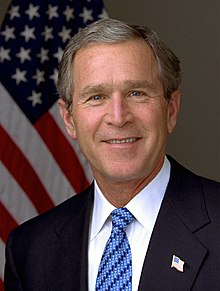
“After graduating from Yale University in 1968 and Harvard Business School in 1975, Bush worked in oil businesses.” 
“Early on, the Bush administration withdrew from a number of international treaty processes, notably the Kyoto Protocol on global warming.” 
“Bush successfully ran for re-election against Democratic Senator John Kerry in 2004, in another relatively close election.” 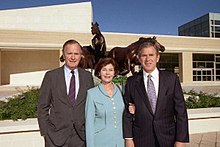
“After leaving office, Bush returned to Texas and purchased a home in a suburban area of Dallas.” 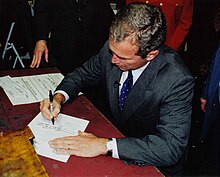
“George Walker Bush was born in New Haven, Connecticut at Grace-New Haven Hospital (now Yale – New Haven Hospital), on July 6, 1946, the first child of George H. W. Bush and Barbara Bush (née Pierce).” 
“Bush attended public schools in Midland, Texas until the family moved to Houston after he completed seventh grade.” 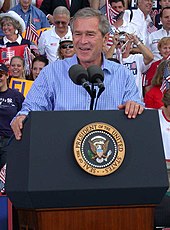
“Bush finished his high school years at Phillips Academy, a boarding school (then all-male) in Andover, Massachusetts, where he played baseball and during his senior year was the head cheerleader.” 
“In May 1968, Bush was commissioned into the Texas Air National Guard.” 
“In late 1972 and early 1973, he drilled with the 187th Tactical Reconnaissance Group of the Alabama Air National Guard, having moved to Montgomery, Alabama to work on the unsuccessful U.S. Senate campaign of Republican Winton M. Blount.” 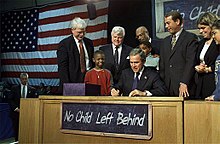
“In 1977, he was introduced by friends at a backyard barbecue to Laura Welch, a school teacher and librarian.” 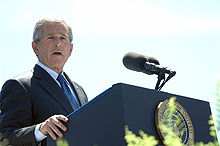
“Prior to his marriage, Bush had multiple episodes of alcohol abuse.”
“Bush says his wife has had a stabilizing effect on his life, and attributes to her influence his 1986 decision to give up alcohol.”
“In 1978, Bush ran for the House of Representatives from Texas’s 19th congressional district.”
“Bush moved his family to Washington, D.C. in 1988 to work on his father’s campaign for the U.S. presidency.”
“In December 1991, Bush was one of seven people named by his father to run his father’s 1992 Presidential re-election campaign as “campaign advisor”.”
“As Bush’s brother, Jeb, sought the governorship of Florida, Bush declared his candidacy for the 1994 Texas gubernatorial election.”
“After easily winning the Republican primary, Bush faced popular Democratic incumbent Governor Ann Richards.”
“Bush used a budget surplus to push through Texas’s largest tax-cut, $2 billion.”
“In 1998, Bush won re-election with a record 69% of the vote.”
“Throughout Bush’s first term, national attention focused on him as a potential future presidential candidate.”
“In June 1999, while Governor of Texas, Bush announced his candidacy for President of the United States.”
“Bush portrayed himself as a compassionate conservative.”
“Bush won the Iowa caucuses, but, although he was heavily favored to win the New Hampshire primary, he trailed McCain by 19% and lost that primary.”
“On July 25, 2000, Bush surprised some observers by asking Dick Cheney, a former White House Chief of Staff, U.S. Representative, and Secretary of Defense, to be his running mate.”
“Bush continued to campaign across the country and touted his record as Governor of Texas.”
“When the election returns came in on November 7, Bush won 29 states, including Florida.”
“In 2004, Bush commanded broad support in the Republican Party and did not encounter a primary challenge.”
“The Bush campaign advertised across the U.S. against Democratic candidates, including Bush’s emerging opponent, Massachusetts Senator John Kerry.”
“In the election, Bush carried 31 of 50 states, receiving a total of 286 electoral votes.”
“Bush was sworn in as president on January 20, 2001.”
“In a February 28, 2001, message to the Congress, Bush estimated that there would be a $5.6 trillion surplus over the next ten years.”
“Under the Bush Administration, real GDP grew at an average annual rate of 2.5%,[98] considerably below the average for business cycles from 1949 to 2000.”
“In December 2007, the United States entered the longest post–World War II recession,[15] which included a housing market correction, a sub prime mortgage crisis, soaring oil prices, and a declining dollar value.”
“Many economists and world governments determined that the situation became the worst financial crisis since the Great Depression.”
“In November 2008, over 500,000 jobs were lost, which marked the largest loss of jobs in the United States in 34 years.”
“Bush undertook a number of educational priorities, such as increasing the funding for the National Science Foundation and National Institutes of Health in his first years of office, and creating education programs to strengthen the grounding in science and mathematics for American high school students.”
“One of the administration’s early major initiatives was the No Child Left Behind Act, which aimed to measure and close the gap between rich and poor student performance, provide options to parents with students in low-performing schools, and target more federal funding to low-income schools.”
“After being re-elected, Bush signed into law a Medicare drug benefit program that, according to Jan Crawford Greenburg, resulted in “the greatest expansion in America’s welfare state in forty years;” the bill’s costs approached $7 trillion.”
“Following Republican efforts to pass the Medicare Act of 2003, Bush signed the bill, which included major changes to the Medicare program by providing beneficiaries with some assistance in paying for prescription drugs, while relying on private insurance for the delivery of benefits.”
“Bush began his second term by outlining a major initiative to reform Social Security, which was facing record deficit projections beginning in 2005.”
Conquer the web with ExcitingAds!
Browse our Blog
Read our article Get Mad! Country Going Down, Part 3 and Get Mad! Country Going Down, Part 5
Shrink Shop
Of course, what a magnificent site and informative posts, I will bookmark your website.Have an awsome day!
I do accept as true with all the ideas you have presented for your post. They are very convincing and can certainly work. Nonetheless, the posts are too quick for beginners. May just you please prolong them a little from next time? Thanks for the post.
Article submission is an extremely powerful process and too be honest I am not sure wether i agree with doing it automatically. My current SEO stratergys for article marketing are fairly simple. I outsouce an article to be written by a professional english writer, the article must contain at least 1,200 words and be of extremely high quality. Next i will submit it to the top 20 article websites based on Page Rank and traffic. After submitting the articles i will then do some basic backlinking and bookmarking to make sure they get indexed by the search engine spiders. I find that doing article marketing this way works extremely effective however i suppose that having the software submit less quality articles to the less dominant websites and then submit to the ones manually that you can’t use a tool for with your quality article because at the end of the day quality backlinks never hurt anyone.
I like this blog so much, saved to my bookmarks .
magnificent post, very informative. I wonder why the other experts of this sector do not notice this. You must continue your writing. I’m sure, you have a huge readers’ base already!